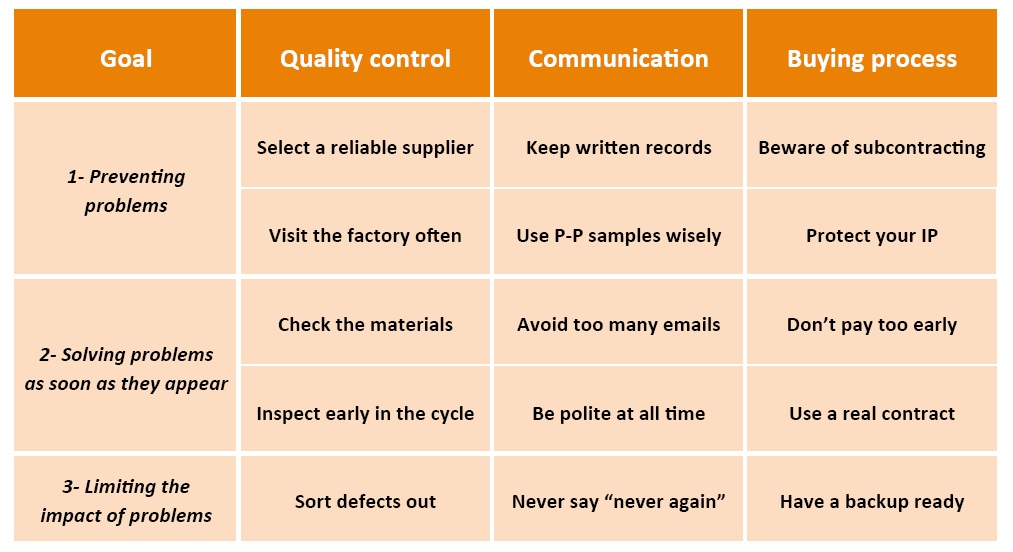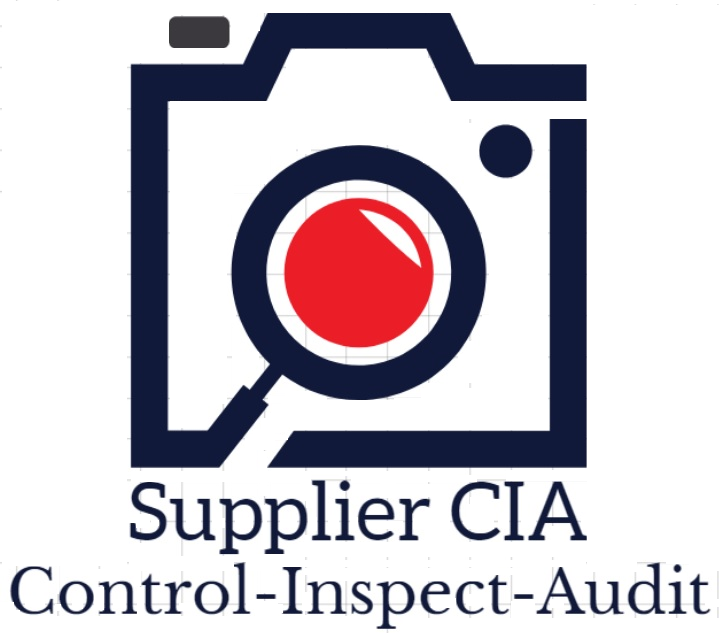Thanks a lot, Renaud Anjoran from qualityinspection.org for his important recommendations about “How to Deal with Suppliers?”
It’s mostly written for Chinese suppliers however including more general and applicable information to be able to use for different countries. Let’s start with the following table he prepared.

Preventing Problems
1. Select capable and reliable suppliers: The longer you expect to work with them, the more you should invest at the first stage.
Good fit for you: the right size, the right type of customers, the right focus (low cost vs. high quality), sufficient development capabilities. Background checks by calling two of their long-‐time customers. Visit the factory and/or pay for a capacity audit performed by a third-‐party quality assurance (QA) firm.
2.Beware of subcontracting: Developing a product with a supplier who does not know where to manufacture it yet. You can also send an inspector who will report on the location of the production
3. Keep written records of all promises: quality standards should never be negotiable. If you accept substandard quality once, the factory will remember it and will see it as your “real” standard!
4.How to use pre-production samples: want a perfect sample before production starts. , Take clear photos of the problems with arrows pointing at the problems.
5.Visit the factory frequently: come regularly to China and talk to the middle managers (who allocate capacity and set priorities) and/or the technicians working on your orders
6.Don’t put all your IP in one company’s hands: If you do not want your supplier to turn into your competitor, you should take a few precautions. Distribute the processing across several factories (located in different cities), assembly & packing to a manufacturer that does not know the other factories.
Solving Problems Fast
7. Check materials before final assembly starts: substandard components shouldn’t be used. If possible, find the sub-‐suppliers yourself (can be more expensive and time-consuming). catch Problems early by sending an inspector when the main materials are delivered, and before production starts.
8. Check quality early in the manufacturing cycle: If you define quality issues whole production is completed, re-‐working the defective goods takes weeks. Send an inspector as soon as some finished products get off the lines. This way, issues are noticed early, the factory can implement corrective actions, and you can adapt your planning. The inspector will use the specifications you have written as a checklist, and if possible an approved sample.
9. Communicate mostly in person / over the phone: If inspector, has found a problem. If you are not on site, you should send emails to convey information (photos, lists of problems…) and to ask for a response. Then you can call your contact person and ask them when they will respond.
10. Be polite at all time: Be assertive, but be polite.
11. Release payments after milestones are reached: Payments by bank wire (TT) a 30% deposit before the materials are ordered, and the transfer of the balance after shipment. The final payment takes place after product quality was confirmed.
Payments by letter of credit (LC) are more complex but more protective of the buyer. You should include a “certificate of quality control by [your nominated QA firm]” among the documents to be provided by the supplier.
Never transfer money to a private account
12. Sign an enforceable contract: A contract also called “OEM agreement” that you can enforce in a court before you wire a deposit (or open an LC). It should be prepared by a specialized lawyer including; Written description of the product, Subcontracting can be forbidden, Payment terms, IP non-disclosure.
It is one-time fee so, It should be structured so that only the exhibits (product specs, purchase order…) need to be changed from one order to another.
Reducing the Impact of Problems
13. Sort defective goods with a 100% check: If you found that 40% of production samples are defective: You can cancel the order,or ask them to rework/reproduce,
Check 100% of production. Then you will know precisely what can be shipped immediately, what can be repaired, and what cannot be repaired.
14. Line up a backup factory: Drop untrustworthy factories as soon as possible. In this case, you will need a backup factory. Especially for important projects by working on product development with two factories. Depending on their performances, you will select one of them.
15. Never say never again: Do not draw definite conclusions about a supplier. Don’t cancel orders or refuse payments simply to “give them a lesson”.
When you plan to change your best suppliers you might be happy to work again with an old supplier.
Impact of relationship with suppliers to the business:
Not building relationships with suppliers:They can offer new ideas or can point out helpful products in development that could benefit organizations. Without regular communication, you may miss out on savings, new supplier programs, opportunities for innovation, and more.
Being too close: when problems pop up (for example, a price increase supported by a dubious excuse), they don’t dare to say no. Just like they don’t dare to insist for an inspection of quality before shipment.
Being too distant: Don’t try to lock in to one vendor but keep shucking between multiple vendors always switching (which in my opinion, leads to always “reinventing the wheel.”
If you are categorized as a “bad buyer” management will not look after your orders closely (which means more delays), and they will be more inclined to cheat you (which means lower quality). Make sure you show your suppliers that you care about their situation, and give them regular orders. Then your sourcing experience will be much more pleasant.

